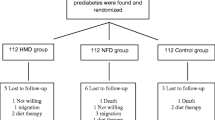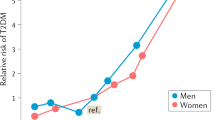Abstract
Evidence suggests that diet and exercise are associated with improved glucose tolerance for patients with non-insulin-dependent diabetes mellitus (NIDDM). Seventy-six volunteer adult patients with NIDDM were each assigned to one of four programs: 1) diet, 2) exercise, 3) diet plus exercise, or 4) education (control). Each program required ten weekly meetings. Detailed evaluations were completed prior to the program and after three, six, 12, and 18 months. Evaluations included various psychosocial measures, measures of the quality of life, and fasting blood glucose, glycosylated hemoglobin, and relative weight determinations. Of the 76 original participants, 70 completed the 18-month follow-up study. At 18 months, the combination diet-and-exercise group had achieved the greatest reductions in glycosylated hemoglobin measures. In addition, this group showed significant improvements on a general quality of life measure. These improvements were largely uncorrelated with changes in weight. The authors conclude that the combination of dietary change and physical conditioning benefits NIDDM patients, and that the benefits may be independent of substantial weight loss.
Similar content being viewed by others
References
University Group Diabetes Program: Effects of hypoglycemic agents on vascular complications in patients with adult-onset diabetes. VIII: Evaluation of insulin therapy: final report. Diabetes 1982;31(suppl 5)
Doar JHWH, Wilde CE, Thompson ME, Sewell PFJ: Influence of treatment with diet alone on oral glucose tolerance test and plasma sugar and insulin levels in patients with maturity-onset diabetes mellitus. Lancet. 1975;1:1263–6
Olefsky J, Reaven GM, Farquhar JW: Effects of weight reduction on obesity: studies of lipid and carbohydrate metabolism in normal and hyperlipoproteinemic subjects. J Clin Invest, 1974;53:64–76
Wing RR, Epstein LH, Nowalk MP, Koeske R, Hagg S: Behavior change, weight loss, and physiological improvements in Type II diabetic patients. J Consulting Clin Psychol 1985;53:111–22
Foreyt JP, Goodrick GK, Gotto AM: Limitations of behavioral treatment of obesity: review and analysis. J Behav Med 1980;4:159–74
Kaplan RM, Bush JW: Health-related quality of life measurement for evaluation research and policy analysis. Health Psychol 1982;1:61–80
Nathan DM, Singer DE, Hurxthal K, Goodson JD: The clinical information value of the glycosylated hemoglobin assay. N Engl J Med 1984;310:341–6
Kaplan RM, Atkins CJ, Timms RM: Validity of a quality well-being scale as an outcome measure in chronic obstructive pulmonary disease. J Chronic Dis 1984;37:85–95
Kaplan RM, Bush JW, Berry CC: Health status index: category rating versus magnitude estimation for measuring levels of well-being. Med Care 1979;17:501–23
American Diabetes Association: Exchange lists for meal planning. New York: Author, 1976
Ferguson J: Habits not diets. Palo Alto: Bull Publishing, 1975
Marquis K, Ware JE: New measures of diabetic patient knowledge, behavior, and attitudes. Santa Monica: RAND Corporation, 1979
Kaplan RM, Wilson DK, Hartwell SL, Merino KL, Wallace JP: Prospective evaluation of HDL cholesterol changes after diet and physical conditioning programs for patients with type II diabetes mellitus. Diabetes Care 1985;8:343–8
Arky RA, Wylie-Rosett J, El-Beheri B: Examination of current dietary recommendations for individuals with diabetes mellitus. Diabetes Care 1982;5:59–63
Vranic M, Berger M: Exercise and diabetes mellitus. Diabetes 1979;28:147–63
West KM. Epidemiology of diabetes and its vascular lesions. New York: Elsevier-North Holland, 1978
Barrett-Connor E, Wingard D. Sex differentials in ischemic heart disease mortality in diabetics: a prospective population-based study. Am J Epidemiol 1983;118:489–96
Lipid Research Clinics Program Epidemiology Committee. Plasma lipid distribution in selected North American populations: the lipid research program prevalence study. Circulation 1979;60:427–39
DCCT Research Group. The diabetes control and complications trial (DCCT) design and methodologic consideration for the feasibility phase. Diabetes 1986;35:530–45
Author information
Authors and Affiliations
Additional information
Supported by Grants R01 AM 27901 and K04 HL 00809 from the National Institutes of Health to R. M. Kaplan.
Rights and permissions
About this article
Cite this article
Kaplan, R.M., Hartwell, S.L., Wilson, D.K. et al. Effects of diet and exercise interventions on control and quality of life in non-insulin-dependent diabetes mellitus. J Gen Intern Med 2, 220–228 (1987). https://doi.org/10.1007/BF02596443
Issue Date:
DOI: https://doi.org/10.1007/BF02596443




